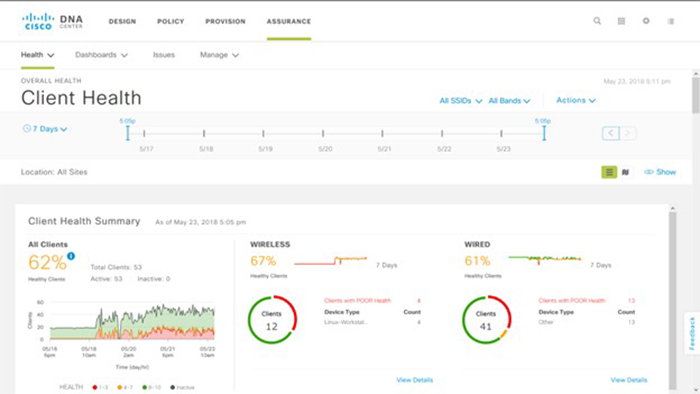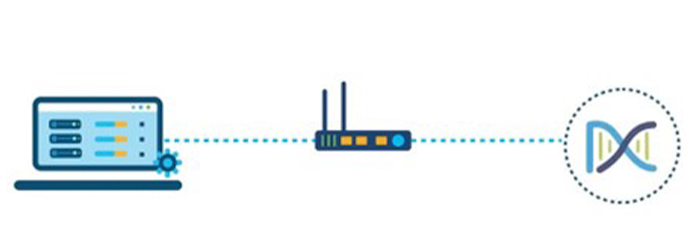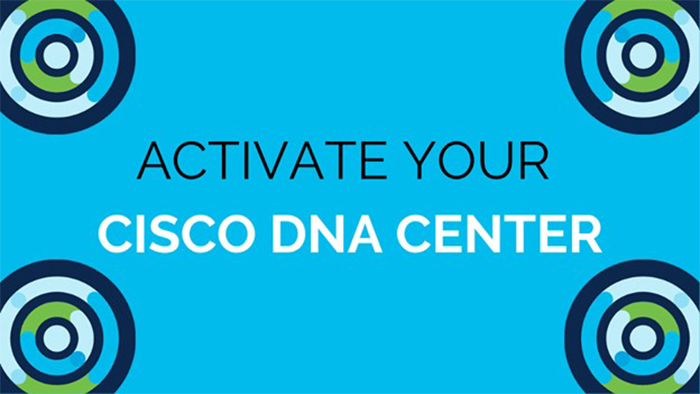The newest release from Cisco DNA Center Virtual is 2.3. 3, which offers improvements in network configuration, change management, and the capability to track ThousandEyes test results directly in Cisco DNA Center, benefits customers. This licensed solution AI-enhanced radio resource management (RRM) for wireless networks allows customers to automate time-consuming RF tuning. Customers will benefit from improved security thanks to the Cisco DNA Center’s integration with Cisco’s Talos IP reputation engine, which detects unauthorized open ports and weak credentials.

Cisco DNA Center Virtual
Recent developments in Cisco DNA Center’s AI-enhanced radio resource management (RRM) have taken advantage of AI/ML to develop a thorough understanding of particular wireless environments and make configuration suggestions that enhance the Wi-Fi network’s performance, coverage, and capacity.
The network operator can now preview the effects of RRM changes thanks to the new AI RRM simulator that we’ve included in this release. The network administrator will be able to: when Cisco DNA Center advises RRM setting changes, or when the network administrator plans changes to settings like channel, channel width, and power.
Events involving the network infrastructure and network users can cause network devices to produce enormous volumes of data. For network administrators, correlating all the events to determine which ones are pertinent can be difficult due to the volume of data.
The new global assurance event viewer gives the network administrator a consolidated view of events from all the devices, where they can search and filter on the events that are most crucial to address. The user can: using the event viewer.
Endpoints that attempt to access vulnerable, infected, or malicious websites pose a serious security risk. The Talos IP and Domain Reputation Center and Cisco DNA Center are now connected, allowing the Cisco DNA Center to detect when endpoints attempt to access websites with a bad reputation. The network administrator can take manual or automatic corrective action after these threats are discovered to lower the risk.
Without incurring additional licensing costs, customers want to migrate their access layer to a fabric. With older versions of Cisco DNA Essentials licenses, it was not possible to combine existing layer 2 switching networks into a fabric with earlier versions of Cisco DNA Center. Customers can now integrate new or pre-existing Layer 2 switches with Cisco DNA Essentials licenses into an Cisco SD-Access fabric while preserving the access layer network architecture of the switches.
Wireless network administrators’ perceptions of and interactions with the wireless network in their physical spaces have been completely transformed by the Cisco Wireless 3D Analyzer. A new level of coverage validation has been made available to users thanks to 3D views, which have completely changed how wireless networks are planned and deployed. This improves user experience by ensuring that the actual coverage adheres to the intended specifications.
Using connectivity with Cisco Spaces to provide client location on 3D map views, Cisco DNA Center is enhancing its 3D troubleshooting capabilities as of this release. Administrators are assisted in correlating user location and experience by granular visibility into the wireless coverage where the users are. A deeper level of wireless-client troubleshooting capabilities is offered by workflows to the Client 360 page.
You can manage your network, maximize your Cisco investment, and cut costs on IT with the help of the licensed Cisco DNA Center virtual, a potent network controller and management dashboard. To make managing your network easier, Cisco DNA Center offers a single dashboard for all essential management tasks. With the help of this platform, IT can react to adjustments and difficulties more quickly and intelligently.

A flexible and open platform enables communication between Cisco DNA Center and applications and processes from other parties in terms of data and intelligence. By automating workflow procedures using network intelligence from the licensed Cisco DNA Virtual Center, this enhances IT operations.
Make every network node a sensor capable of continuously streaming telemetry on user connectivity and application performance in real time. In combination with automatic path-trace visibility, guided remediation, and this, network issues are quickly fixed before they become bigger issues. Threat detection and mitigation are made possible even when they are cloaked in encrypted traffic by automated NetFlow switch configuration for Cisco Secure Network Analytics.
Define user and device profiles that enable highly secure access and network segmentation based on business needs. Your business-critical applications can deliver a constant level of performance regardless of network congestion thanks to application policies.
Start by deciding where you’ll deploy your network devices before using simple workflows to design your network. Existing network designs and device images can be easily imported into Cisco DNA Center by users of Cisco Prime Infrastructure and the Cisco Application Policy Infrastructure Controller Enterprise Module (APIC-EM).
All system users can now receive monthly emails from the licensed Cisco DNA Virtual Center, which includes curated content and personalized network information for each user. Customers can choose to:
Basic automation (inventory, discovery, SWIM, topology, and template programmer) and assurance support for Cisco Catalyst 9500 and 9400 Series StackWise Virtual switches. The Cisco Catalyst 9000 platform’s StackWise Virtual technology enables clustering, which improves high availability, scalability, management, and maintenance of networks by combining two physical switches into a single logical entity. Customers can now manage the StackWise Virtual device and check the status and health of the StackWise Virtual ports and links using the licensed Cisco DNA Virtual Center.
Workflows for day-0 routers, NFV design, and physical and virtual branch automation that are simplified. Follow these simple steps to onboard WAN devices and services.
Millions of spatial RF data points are analyzed in great detail by the Wireless 3D Analyzer, which also allows users to see wireless coverage. Network administrators can determine which regions are most impacted by RF strengths, view client locations, simulate various RF environments, and perform spatial planning and interior environment prediction.
Network administrators can enter a virtual office space, move an access point, or construct an fictitious wall to see the effects on Wi-Fi signal propagation after loading basic architectural structural information. The Wireless 3D Analyzer assists network administrators in maximizing WLAN performance and quickly pinpointing problem areas and WLAN design flaws.

On the Cisco Switch, Cisco Router, or wireless controller where the anomaly was found, assurance and analytics are carried out. Before an incident happens, critical metrics can be found and immediately used. Core business KPIs can be kept current in real time and close to the users who depend on them.
Supports a direct communication link between the Cisco DNA Center and the APs, enabling direct communication between the APs and the Cisco DNA Center. Data on packet capture, AP and client statistics, and spectrum information can all be sent to Cisco DNA Center using this channel. You can access data from APs that aren’t accessible through the wireless controllers with Cisco Intelligent Capture thanks to the direct communication link between the Cisco DNA Center and APs.